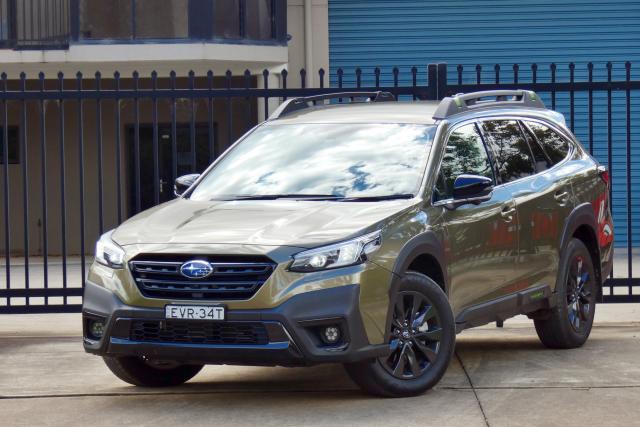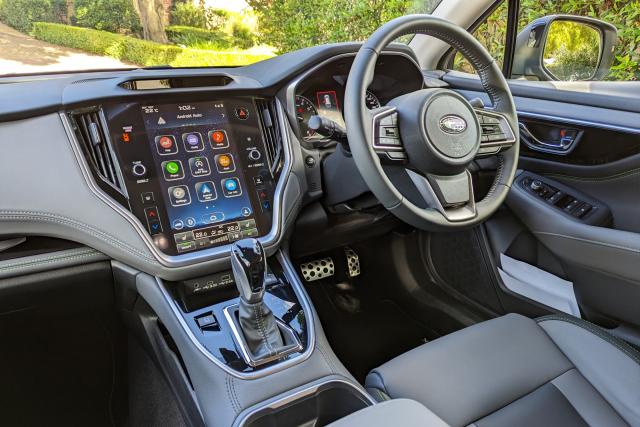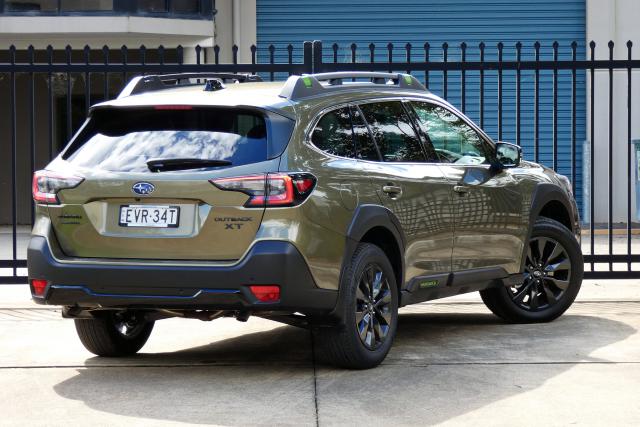After all these years, I still think of the Subaru Outback as a wagon rather than SUV — the Forester too.
Unfortunately, you can’t buy a diesel Outback anymore, but the latest turbocharged petrol version certainly addresses any perceived deficiencies in performance.
And, like a fine wine, Outback continues to get better with age.
Its one major gap in an otherwise impressive repertoire remains the fact that it seats only five. In fact, Subaru hasn’t offered a seven-seater as part of its range since the propeller-nosed Tribeca in 2013.
But you’re not likely to receive any complaints from those five passengers in a car that really sets a benchmark for comfort and features, given its relatively modest price.
STYLING
Prices for Outback start from $42,690. Two turbocharged versions are offered: Outback AWD Sport XT is $52,190 while Outback AWD Touring XT is $55,990 – $5000 more than their standard counterparts.
To distinguish turbo models, they feature dual tailpipes to go with the extra performance, although they are barely visible below the back bumper.
There’s also an ’XT’ badge (remember the powerhouse XT Forester) and LED fog lights that are made up of six LEDs – we’re told it’s an homage to the Subaru badge which features six stars.
INFOTAINMENT
Subaru was slow to the infotainment party, but has made up for lost time with a big, impressive system that’s dominated by a large 11.6-inch tablet-style touchscreen.
It has been redesigned to make it more user friendly, with new shortcut buttons, updated climate control buttons and full screen Android Auto.
XT Sport features Bluetooth, voice control, AM/FM and DAB+ Digital radio, built-in satellite navigation, plus wireless Apple CarPlay and Android Auto connectivity, along with six-speaker audio. The CD player has gone to God.
Physical buttons such as the climate control panel have been integrated into the screen, with convenience and operability prioritised through shortcut switches for some frequently used features.
SAFETY
Five-star safety starts with eight airbags, a rear-view camera and Autonomous emergency braking (Car to Car, Vulnerable Road User, Junction Assist and Backover).
EyeSight 4.0 features roadside speed sign recognition, adjustable speed limiting, and intersection crash avoidance using new cameras with a wider field of view and a lower profile inside the cabin.
There’s also a lane support system with lane keep assist (LKA), lane departure warning (LDW) and emergency lane keeping (ELK) and an advanced speed assistance system (SAS).
DRIVING
Apart from the turbocharged engine, the other big change is the switch to the Subaru Global Platform (SGP), which is stiffer and provides the scope to use alternative powertrains — such as hybrid or fully-electric setups.
With maximum torque kicking in from a low 2000 revs, Subaru says the turbo does the dash from 0-100km/h about 22 per cent quicker than naturally aspirated models (but they don’t reveal what that time is).
Auto Stop-Start now incorporates “Change of Mind Control“ which as its name suggests, restarts the engine within 0.2 of a second — if you change your mind.
Although described as symmetrical all-wheel drive, like most systems these days it is actually a part-time system with torque transmitted to the rear wheels as required (read the fine print).
In manual mode the CVT features seven steps or simulated gears, with the addition of Intelligent and Sport modes plus two-mode X-Mode for off-road driving.
With 213mm of ground clearance, X-Mode is designed for use below 40km/h with one setting optimised for snow and dirt and the other for deep snow and mud.
Fuel consumption from the 63-litre tank is a claimed 9.0L/100km compared to 7.3L/100km for the standard model, and it takes premium 95 unleaded.CO2 emissions are 204g/km.
The suspension has been re-tuned to accommodate the new engine, with different settings for the springs and dampers, and the result is first rate.
The extra torque of the turbocharged engine has also allowed the tow capacity to be increased 400kg, up from 2000 to 2400kg.
Outback is easy to get in and out of, with a cabin that is a nice place to be.
The seats are large and comfy, something Subaru has always done well, and the ride is quiet and buttery smooth (in contrast to the Jeep we drove previously).
All-round vision is excellent and you can see where the front of the bonnet is when it comes to parking.
The large physical blind spot lights that never fail to capture attention.
Elbow room is a bit snug however, so be sure to try it on for size.
The interior layout looks pretty much the same as the previous Outback that we drove a couple of years back, but the front seats have been redesigned with advanced shaping and support to reduce fatigue over longer distances.
Although the infotainment system looks impressive, the instrument cluster has a bit of catching up to do.
It retains old-style analogue gauges that flank a small central driver info screen with fuel consumption figures etc.
We finished on 10.1L/100km after close to 400km of mixed driving, but expect this to be higher around town.
SUMMING UP
The Subaru Outback is not perfect, but that is the word that springs to mind.
The turbocharged engine adds some punch and extra towing ability, but be prepared to pay a penalty in fuel consumption.
However, it’s the comfort and ride quality that leave a lasting impression — one that you’ll want to take home.
The next step in the evolution of the wagon is a hybrid version, followed we assume by a fully-electric Outback sometime down the track.









